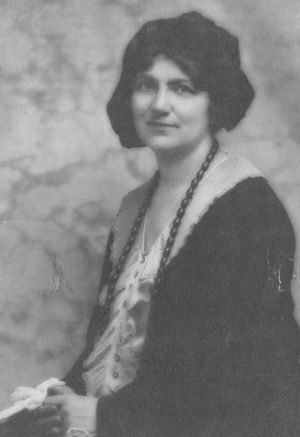
Margaret McClure Stitt's contribution to the literature of song has not received the recognition it deserves. In her own circle, which included a number of woman's clubs and music clubs in Cincinnati and nearby cities, Mrs. Stitt was well-known, loved, and admired. Since most of the performances of her songs took place in these clubs—the province of society editors rather than of music critics—she received little or no critical notice. After her New York program under the auspices of the New York Madrigal Society in 1931, an article did appear in the Musical Courier. It was quite favorable, even enthusiastic, but it was largely descriptive rather than critical or evaluative.
While she published operetta and songs in the field of school music, and some popular songs in the late 1920s, it was only at the beginning of her career that she published any of her art songs. Her first song, Lullaby, was published when she was twenty and six years later, just before her marriage, she published a book of ten songs including the earlier Lullaby. Some years later she considered publishing a revised edition of these songs under the title Student Songs. She made a note on the copy on which she had indicated alterations: "Since realizing that these songs were imperfectly written, I haven't tried to do much with them. Have hoped to re-edit them and turn over to a publisher."
Not "imperfectly written" in my judgment, for they are direct and well-composed, attractive in melody and natural in harmony; "imperfectly notated" perhaps, for there are certain irregularities in the notation of harmony and rhythm; but by and large the composition of these pieces—very like folk songs—is "right." Margaret Stitt had from the beginning a very sure hand, and this is why, when she did try to improve a song, she nearly always returned to the first version. We shall presently discuss the Lullaby and some of the revisions, but before we take up her songs in detail we should learn a little about her early childhood and education to understand her modesty and her exaggerated respect for the traditionally trained composer. Her extraordinary gifts of perception and memory, which appear as an intuitive knowledge of what to write, caused her some embarrassment, for she felt she lacked the rigorous training a composer needs. She would say, "I am not a composer, just a gipsy writer."1
I
Margaret Lorna McClure was born in Rarden, Ohio, in Scioto County about 25 miles north of Portsmouth, in 1886. Her mother died when Margaret was only three-and-a-half years old and her mother only twenty-seven. ("She had TB, which in those days was fatal," Margaret wrote.) Margaret was raised by her mother's people, at first in Locust Grove and later in Waverly, where she was graduated from high school in 1903.
Her first music lessons were with a cousin in Locust Grove, Philomela Cutter. She studied exercises at first but when she was seven years old was given her first "piece," "real sheet music," she said later, a gift from her teacher. Her account of her lessons, written some 70 years later, has a great deal of charm.
I treadled by tricycle (with red plush seat & fringe) the mile from Locust Grove to Miss Phiola's house across from [the] cemetery, pulling it up the hills. I grew to know every fence corner on the way. Miss Phiola & her half sister, Miss Mary Copeland, also [a] brother, made their home together. On my lesson days I generally stayed several hours. Afterwards Miss Mary always had good things for me to eat. I still remember her tiny apple butter turnovers. I also remember the new little chickens lightly wrapped & in a basket near the cook stove. I gave them some loving exercise, then put them carefully back to keep warm.
Think my father paid 50¢ per lesson, but considering my "refreshments" while there, Miss Phiola didn't clear much from that. These lessons were on the organ, and I got much joy practicing and playing on the organ in the parlor at "Home." I did not study piano until 1897 when I went to Waverly to live, after [my father's] second marriage. Mamma sang (was Welsh) & saw to it that I practiced. Also she played duets with me. My own mother loved music & wanted me to have as much as possible. I have a Schottische which she "composed" which I learned from Aunt Ella, by ear. (Written Jan. 28, 1966)
Margaret preserved the copy of her first piece (to which the above account was attached), with its inscription "To Maggie, From Her Teacher." It was called The Sack Waltz, whether named after the coat or the wine or perhaps the potato sack, I don't know. It is a very simple, very orderly assembly of eight measure phrases with a Chopin-like "sigh" in the main theme which perhaps accounts for its popularity—the cover advertises that it had sold 500,000 copies.
Ex. l
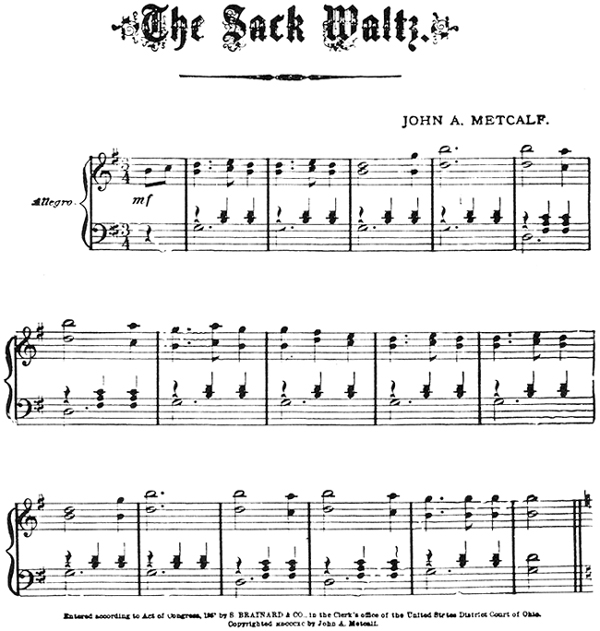
I have not found much information about Margaret's piano study in Waverly between 1897 and 1903. She must have accomplished a great deal, but when she entered the College of Music of Cincinnati in 1904 she felt inadequately prepared. She knew scales (all of them) and Czerny's School of Velocity, but not arpeggios, no Clementi, Cramer, Kullak, she discovered; and many items of standard literature were still outside her acquaintance. Her new teacher, Frederick Hoffman said to her, very kindly she says, "Miss McClure, it's a perfect shame, what little bit you know." When he assigned her Mozart sonatas and a Beethoven concerto and she asked, why not technical studies, Clementi, etc., he replied that she didn't need them—comprehension went ahead of technique.
It was at the time of her graduation from high school that Margaret wrote her first composition—at least the first that we know about. Japinsky, March and Two-Step, was composed in 1903 and published the following year by W.H. Willis & Co., then situated at the southeast corner of Fourth and Elm Streets in Cincinnati. The year of publication coincided with the beginning of the Russo-Japanese War, and the freshly minted title, Jap plus Insky, served to give the work a timely dress. (On the manuscript a title with a line drawn through it suggests that the march was conceived as The Imps of Vulcan.) A brass band arrangement of the march was scheduled for an afternoon concert in Eden Park, but a torrential rain prevented that performance.
Ex. 2
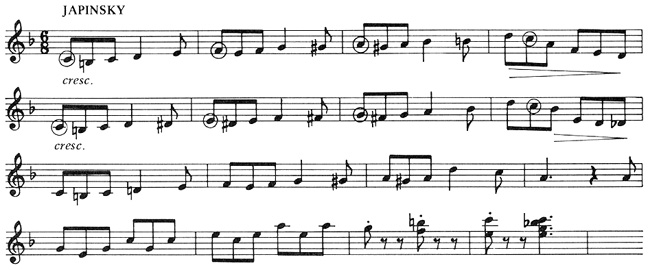
The music is good. In manner and proportion it is in the Sousa tradition, and it is a remarkably finished work for a seventeen-year-old just graduated from a rural high school. The principal idea, embellished with chromatic auxiliary and passing tones, outlines tonic and dominant triads for four measures each. In the fourth phrase the melody, modulating to the dominant, abandons chromatic movement for a brisk arpeggio in a fine Mozartean gesture.
Margaret returned to the College of Music in the fall of 1905 for her second year, but her eager practicing brought on trouble, and after five weeks "piano paralysis" forced her to give up playing. She stayed in school until Christmas as her tuition was already paid; Mr. Hoffman spent her lesson time playing, explaining, and teaching in other ways. Then from January to June she was at home, practicing ten minutes at a time. She continued to work at composition, and her next production was the Lullaby of 1906.
Ex. 3
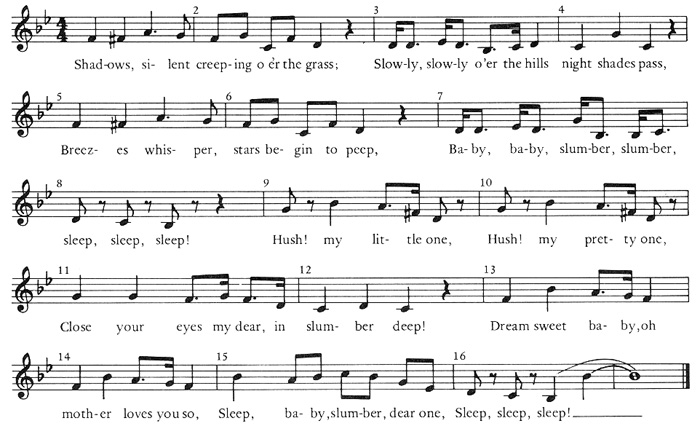
The Lullaby exists in three versions, of which the second (published in the 1912 "Ten Songs") is the definitive one. It includes some changes in the piano accompaniment, but most significant are changes in the rhythmic notation of the third and seventh measures of the voice part, where  is replaced by
is replaced by  on "slowly," "baby," and "slumber").
on "slowly," "baby," and "slumber").
The melody is beautifully formed, and the rhythmic balance and harmonic cross-references produce a satisfying whole. The phrase structure is simple—a glance reveals the two-measure units, combining to form the two eight-measure periods, with half-cadences at the midpoints. The ninth measure introduces a prominent G minor triad and its dominant by way of contrast.
The rhythm reflects the words very naturally, but creatively bringing out the trochaic possibilities in measures three and seven. The second period employs the smoother  and in the fifteenth measure the melody flowers into even eighth notes, reaching its highest point just before the cadential descent. (Riemann might have argued successfully for shifting the barlines two beats forward throughout.) An interesting detail is the use of the four note bass pattern D, D-flat, C, F, from measures one and five, as the bass in measures thirteen and fourteen, harmonized differently (See Ex. 4).
and in the fifteenth measure the melody flowers into even eighth notes, reaching its highest point just before the cadential descent. (Riemann might have argued successfully for shifting the barlines two beats forward throughout.) An interesting detail is the use of the four note bass pattern D, D-flat, C, F, from measures one and five, as the bass in measures thirteen and fourteen, harmonized differently (See Ex. 4).
Ex. 4

The new melody above follows the rhythmic pattern and general shape of measure nine, thus reconciling the contrasting phrase with the opening of the song. "Gipsy" or not, there can be no doubt that Margaret knew quite well what she was doing, whether or not she would have explained it in technical terms.
It is curious that the outline of the first four notes of the melody echoes the intervals and the stress of the climax of the first phrase of Japinsky. We can only speculate whether the composer was aware of the similarity.
Ex. 5

Of the nine other songs included in the 1912 publication, two were used occasionally in Margaret's song programs of the 1930s. These were All's Well That Ends Well and The Old Woman Who Lived in a Shoe. Most of the songs have a simple piano accompaniment, chordal and essentially doubling the melody. Only in When Love is Here does she venture an independent arpeggiated accompaniment. Throughout these songs the harmony reflects the vernacular of the period, relying on the triads of the key, especially tonic and dominant with occasional altered fifths and secondary dominants for color.
For several years following her study at the Cincinnati College of Music the piano problem continued to plague her and she remained in Waverly teaching children. She did have diversions. A 1907 diary records a three-week visit to the Howe military school in Indiana. She enjoyed the social life, the formality, perhaps even the men. (She records going to a dance with "the perfectly good Mr. Wilson.") One afternoon she went to band rehearsal and heard her own Japinsky; and later she writes, "Dinner and band concert, opening with Japinsky."
In 1909 she returned to music school, this time at the Indianapolis Conservatory as a student of piano with Emiliano Renaud, and as a teacher in the day school. Renaud seems to have found the right approach to her problem and her hand gradually returned to normal. He also assigned her an ambitious piano recital program which got under way the next year. But then she learned that her father was coming home to Washington Court House and she could not resist returning to join him. She had sent many summers in Bloomingburg, five miles from Washington, visiting her aunt and uncle and playing with her cousin Roy McClure, so she felt quite at home there. She continued her practicing and did finally give the recital Renaud had laid out, in Washington Court House in 1914.
Meantime, however, she had developed another interest and in October, 1912 Margaret was married to Howard Stitt, a promising young doctor practicing in Washington Court House. They remained there until 1920; then the Stitts, numbering five—for there were now three children, Bob, Martha, and Howard—moved to Cincinnati, settling in Hyde Park. By 1923 Dr. Stitt had decided to go to Vienna to do advanced study in his specialty (otolaryngology), and the whole family went abroad.
II
It is impossible to tell how much writing Margaret did during this period when she was raising her young family, for she rarely dated her music. One song, setting a poem she wrote for her daughter Martha while in Vienna, may well have come from 1924 or 1925 and is a remarkably fine one. The text is a simple poem for a child, but it has mysterious overtones and the sensitive setting underlines the poem beautifully.
MY GOLD BALLOON
I lost my pretty gold balloon
Upon a summer's afternoon.
'Twas such a funny little noise
I thought, at first, some naughty boys
Were surely poking fun at me.But in the night, when all was still,
I saw it peeping o'er the hill.
You see, my pretty gold balloon
Was just the lovely golden moon
Come down from heav'n to play with me.
After the decisive introduction (the little girl's frustration!) the voice begins in a narrative tone. Each line of the stanza follows a similar rhythmic pattern in eighth notes and the piano answers in a like rhythm over an empty fifth in the left hand. (Surely the Vienna experience included Der Leiermann.)
Ex. 6
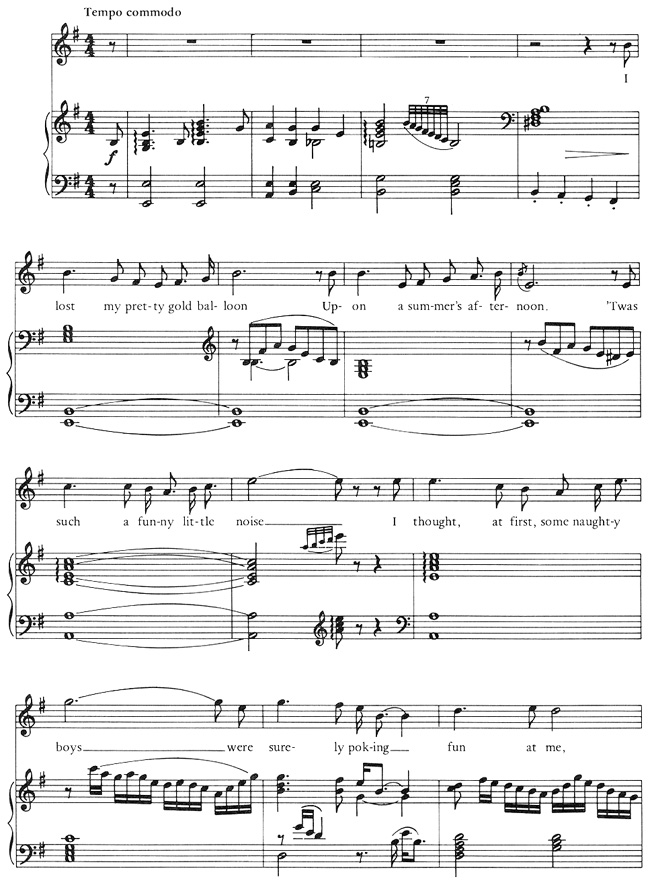
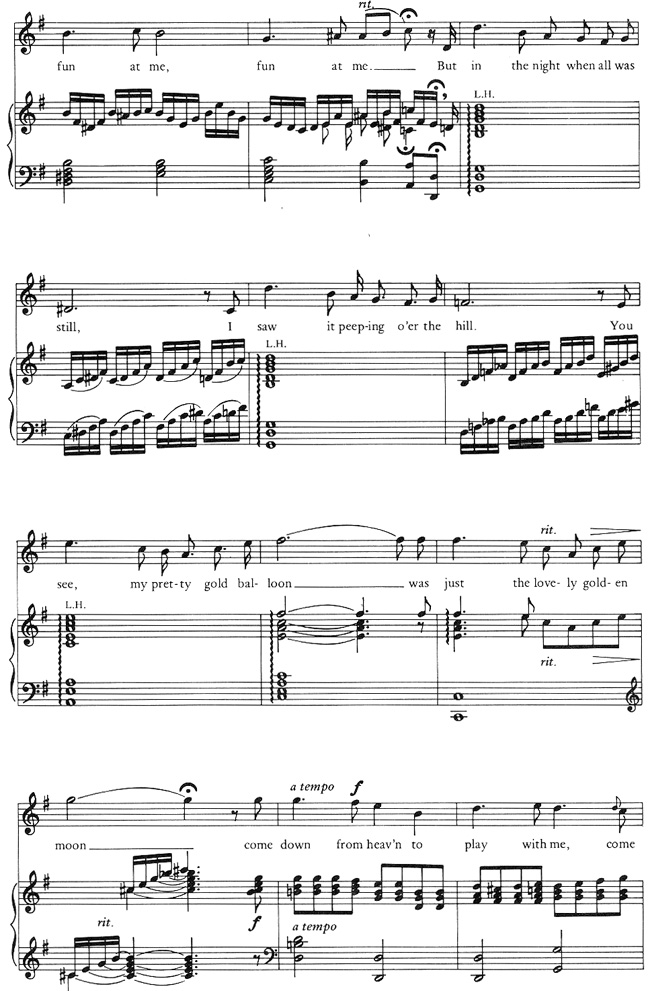
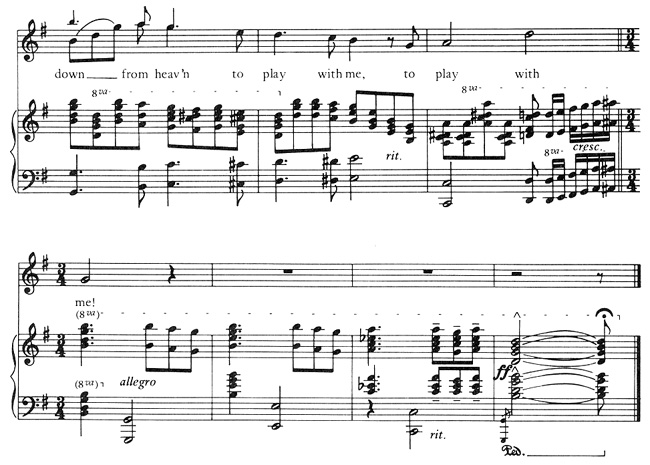
A brief swirl in the right hand suggests the collapse of the balloon, and the thought of the naughty boys' fun is reflected in a lively passage in sixteenth notes, cadencing in the relative major. Mysterious chords hint at the stillness of the night; the voice resumes the rhythmic pattern of the first stanza, in the last line expanding into a flowing six measure conclusion, and the piano adds a triumphant postlude. This is certainly one of the most attractive of Margaret's songs, rewarding to performers and listeners alike.
III
When the Stitts returned to Cincinnati they settled again in Hyde Park. Here Margaret seems to have combined successfully her duties as a wife and a mother with an enormous amount of artistic activity.2 Unexpectedly she took up playwriting. Knowing that she was interested in writing an operetta, Dr. Stitt called her attention to a notice of a workshop theater at the College of Music and suggested that she might sign up for it. So began a long association with the theater and with John Redhead Froome. She did write operettas—two for children, but more important she wrote several one-act plays and two or three full length ones, which were produced successfully. One of her plays won a prize from the National League of American Pen Women.
By this time Margaret had become acquainted with the poets of the Cincinnati Chapter of the Pen Women's League, several of whom became her close friends. She set many of their poems to music. Among these were Mabel Posegate (who became the Ohio Poet Laureate), Frances Emminger, B.Y. Williams, Annette Patton Cornell, Irene Grueninger, Katherine Hunter Coe, and especially George Elliston. A warm friendship grew up between Margaret and George Elliston, who came from Mt. Sterling, Kentucky and who was four years older. Both had a gift for direct communication and both were interested in poems for or about children. Margaret wrote of her:
George Elliston was a newspaper woman all her life. Meantime she wrote "Every Day Poems," which were widely syndicated—never long but always lyrical. . . . Somehow I set one of her poems, Little Leaves, a fluttery, gossamer sort, very delicate. She liked it and had it sung on a Conservatory recital.3
One day she stopped me on Fourth Street, asking if I would set a group of her children's poems. Naturally I said that I would try. She sent me, I believe, 45 or 46 poems. I managed to choose twelve, then narrowed those down to six—enough for a group. . . . Finally I had set twelve of her poems, so with a soprano and a mezzo we gave all-Elliston programs, hither and yon, George reading from her books, then interspersed with songs. It was a great experience and most enjoyable.4
One of the favorite songs to an Elliston text was Circus Days. Margaret tells of the origin of the poem. "One day she called me from her office at the Times Star saying, 'Margaret, I've written a poem for you, "Circus Days." I'm not putting it in one of my books. It's yours.' I still have it in her typing on Times Star copy paper—much value as a poem and for its personal association."
In this song the vigor, spontaneity, and freedom of the words spoke directly to Margaret, who as George knew, loved circuses and action—even in her later years she seemed to have boundless energy. The music (Brillante, Allegro vivace) goes like the wind and gives the impression of a free rondo. The music of the first line returns, sometimes in altered form at the beginning of each stanza.
To show the variety of extensions and distractions I include here a scheme Mrs. Stitt sent to a cousin, showing how she conceived the work. (I have inserted the numbers of the stanzas in brackets and added a few musical examples, since the music is not available in published form.) Margaret comments, "The poem is written in verses, but this is the way it sings."
CIRCUS DAYS
Poem by George Elliston
[1] Who doesn't love a festival,
Festival—festival,
Oh me, oh my, the blood leaps high
Just thinking on a festival.
(Interlude)
Ex. 7

[2] Who doesn't love the happy news
of drums, and gaiety about
and elephants (slow awkward, dissonant chords)
and kangaroos (quick, short skips, up and back)
(Interlude)
Ex. 8


Ex. 9

The news of drums and gaiety about
And elephants—and kangaroos 3 long, slow,
high jumps up
then glissando
crash
back down
(Interlude)
[3] And when the circus comes to town
And it is spring!—and it is spring
Ah ha—spring!
(Interlude)
I cannot keep my laughter down
(acc. staccato ha-has up)
Ex. 10

Inside and out, I sing and sing
[4] Oh, Who doesn't love a festival!
Not me! [text has "Ah me!"] My ecstasy goes
dancing in the wind!
(Interlude)
Ah me! Such glee!
Ah me! Such glee!
Ah (to acc. gymnastics)
Ah—(up octave and hold while acc. does octaves)
A-ha-ha! (quick chords followed by lone drum
roll fff in bass—hopefully in right key!)
Ex. 11

This article treats only four of the songs in detail, but it would not serve its purpose as an introduction to Mrs. Stitt's work if it did not call attention to some other particularly important songs. Among other settings of Elliston poems From a Trundle Bed, Little Leaves, and Time the Conqueror should be mentioned. Memories of her own childhood stirred Margaret to a song of death in Trundle Bed. Little Leaves has much charm, and interesting passage work in the piano part (Chopin and Liszt never very far away); the song also exists in an arrangement for voice, flute and piano.
Next to Circus Days, Time the Conqueror claimed a prominent place in Mrs. Stitt's program. The poem meditates on the strangeness of the thought that it is one's self one sees in the swift procession leading to the grave. The music and the poem make much of the dramatic recognition at the end, "Ah, no—'tis I!, I, too! For if I escape all else, Time wins!" (Though the content is different, the last line of Herbert's Miserie, "My God, I mean myself," comes to mind.) The treatment of the "procession" at the very beginning is simple but impressive, also the sudden shift near the close from the tonic (B-flat Minor) to D-flat Major. In the last two measures the conflict between the dominant of B-flat against the final D-flat chord is dramatic and moving.
Ex. 12
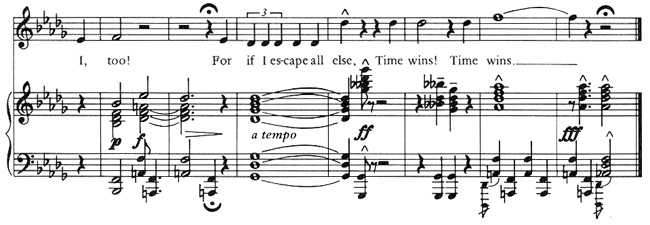
IV
A scrap book Margaret Stitt assembled in later life shows how much she relied on the various music and women's clubs for her audience. In Cincinnati she was a member of the Matinee Musical, the Woman's Music Club, the Cincinnati Woman's Club,5 the Hyde Park Music Club, the MacDowell Society, and the League of American Pen Women, and she was for a long time a sort of mother superior or friend in need to the Delta Omicron musical sorority. She appeared at many other organizations as composer, lecturer, and performer—for example at the Clef Club, the Wyoming Music Club, the Women's Club of Miami University, the Woman's Club of Chillicothe; in Paris, Kentucky, at the Bourbon Women's Club; the Covington Art Club, the Euterpe Club, and many others.6 And she gave a series of lectures on American Music for the University of Cincinnati extension division.
As already noted, she was invited to present an afternoon program of her compositions by the New York Madrigal Society. The program consisted of 18 songs—the composer at the piano, with Abby Morrison Ricker, Verna Carrega, and Sigurd Nilssen as soloists. An article in the Musical Courier, February 14, 1931 commented:
Mrs. Stitt's compositions, aside from their musical value, are particularly interesting from the point of view of variety and versatility. Seldom does an entire program of songs by one composer hold the audience with such interest. . . . It was an unusually well-balanced and interesting program. . . .
Mrs. Stitt participated in several other programs in New York during and shortly after this visit.
Another honor for her was the presentation of a movement from her new Quintet for Piano and Strings, entitled "Soirée," in 1936 at the White House, part of a program of music by composer members of the National League of American Pen Women, in honor of Eleanor Roosevelt. On the same program Mrs. H.H.A. Beach presented three piano pieces reminiscent of the MacDowell colony at Peterborough, New Hampshire.
In 1937 Margaret's eldest son, Bob, died suddenly while he was attending college in Virginia. This sudden loss affected her deeply, and she found she was unable to write any more music. "It was as if a door had closed," she said. She had a manila folder of thematic materials marked, "Ideas I had before Bob passed away. Couldn't, afterwards."
And in the years afterwards she turned to lecturing, developing a large repertoire of talks on musical subjects. She did have one remission from her years of silence as a composer. In the late forties, I believe (though I have not discovered the exact date), Annette Patton Cornell, one of Margaret's Pen Women friends and co-editor with B.Y. Williams of the poetry magazine Talaria, wrote a poem in memory of her sister, entitled Song for Adele. Perhaps because it was a memorial it suddenly appealed to Margaret—evidently the haunting musical imagery of the poem fascinated her. At any rate she was moved to write a song. I think it is probably her finest.
Ex. 13
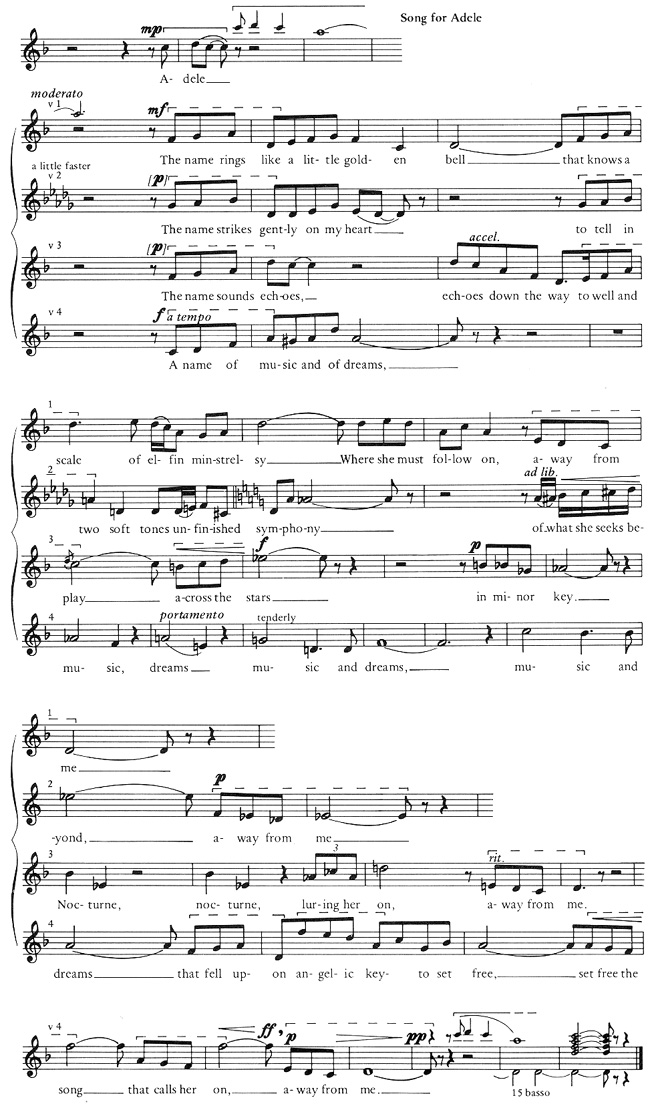
Its haunting beauty owes much to the richness of the text, its rhythm and rhyme scheme, and also to the exquisite and imaginative matching of the music to the poem, both locally where the images are subtly illustrated, but in the understanding and conveyance of the poem as a whole. The opening words, rhyme scheme, and closing phrase of each stanza are reflected closely in the music, but the effect is far from that of a strict strophic setting. As is evident from a glance at the music, the interior measures of each stanza vary widely, and the length of each increases by the elaboration and extension of the melody. The music of each of the four stanzas occupy six, seven, ten and sixteen measures, respectively.
The motto theme  appears only once in the voice, with the name, but recurs constantly in the piano part, calling to Adele, who "must follow on, away from me." The romantic piano arpeggios which occur on "Nocturne" in the third stanza are expanded in the fourth, "a name of music and of dreams," to superbly crafted Lisztian harmonies.
appears only once in the voice, with the name, but recurs constantly in the piano part, calling to Adele, who "must follow on, away from me." The romantic piano arpeggios which occur on "Nocturne" in the third stanza are expanded in the fourth, "a name of music and of dreams," to superbly crafted Lisztian harmonies.
Ex. 14
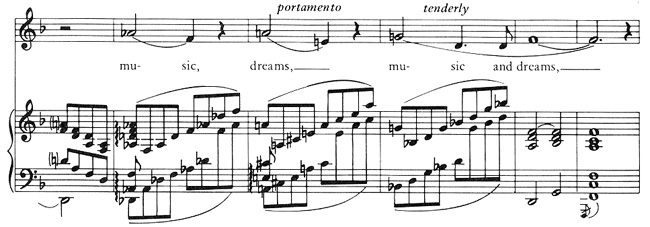
The sudden shift of triads a semitone apart (D Minor to D-flat Major, as seen in Ex. 14) occurs also between the first and second stanzas, where the F Major triad is immediately followed by a G-flat Major triad, embellished by a thematic appoggiatura echoing "Adele." Related, but even more striking, is the shift from a G-flat Major triad to the D Minor triad in the second stanza.
These inspired touches make us regret that Mrs. Stitt did not produce more songs in later life, for while the fine quality of this song may have resulted from the special personal relevance of the poem, the sensitivity and musical skills are to be found in the earlier songs, and the seeds of the transformation and enrichment of the strophic form are evident in My Gold Balloon.
There are many other aspects of Mrs. Stitt's busy and productive life which lie beyond the scope of this brief study—her venture into "popular" music, her contributions to school music, her playwriting, and her successful venture into the lecture field. My purpose has been to indicate the richness of her contribution to the literature of song and to call attention to the treasures which could be available to the discerning performer.
1Margaret's intuitive knowledge mildly exasperated a teacher she visited in the late 1920s, Sidney Durst, who was also my teacher at the College of Music of Cincinnati. She preserved two remarks he made to her: the first, "Your ear saves you a lot of time your head doesn't know about," and the other, "I don't know how you do it. I only know that you don't know how!" Note: The direct quotations in this article from Mrs. Stitt are either from personal letters or from notes attached to publications or manuscripts among her effects.
2A sympathetic interview by Judy Wilensky, published in the Cincinnati Enquirer, December 23, 1962 quotes Mrs. Stitt, "My husband use[d] to say that I was unpredictable. He'd say, 'Maggie, I never know what will be on the dinner table—roast beef or a song you've composed.' . . . Outsiders may have thought we lived rather separate lives. It's true that my husband and I were two distinct individuals with some different interests. But we shared the important things—we loved each other, and the children and our music."
Dr. Stitt had musical interests of his own. He was a skilled violin maker, and some of his instruments have been used by fine artists. Also, as an otolaryngologist he was frequently consulted by soloists appearing in the opera at the Cincinnati Zoo.
3In the foreword to Elliston's Bright World (1927) it is stated that "over a hundred of her poems have been set to music since 1921" when her first collection of poems were published. The composers included Frank van der Stucken, Grace G. Gardner, Louis Victor Saar, Louise Harrison Snodgrass, and Joseph Clokey. Margaret McClure Stitt, Howard Wentworth Hess, and Carlyle Davis are also mentioned as having set her children's lyrics.
Thus it would appear that certain of Margaret Stitt's Elliston songs were composed before 1927, and in this order: Little Leaves, the cycle of six childhood songs, then Circus Days.
4The following listing from a program presented for the Hillsboro Ohio Music Club may serve as an example (dated June 5, 1930).
| I. | Poems from "Cinderella Cargoes" | . . . . . . . . . . . . . . . . . . . . . . . . . | George Elliston |
| II. | Songs of Childhood | . . . . . . . . . . . . . . . . . . . . . . . . . | Margaret McClure Stitt |
| 1. Dreams and Stars | |||
| 2. Kite Lantern | |||
| III. | Poems from "Cinderella Cargoes" | . . . . . . . . . . . . . . . . . . . . . . . . . | George Elliston |
| IV. | Songs of Childhood | . . . . . . . . . . . . . . . . . . . . . . . . . | Margaret McClure Stitt |
| 1. Fairy Princess | |||
| 2. Comparison | |||
| 3. The Weathervane | |||
| 4. Prayers | |||
| V. | Poems from "Cinderella Cargoes" | . . . . . . . . . . . . . . . . . . . . . . . . . | George Elliston |
| VI. | Songs | ||
| 1. It is Springtime (complimentary) | |||
| (Lyric and music by Miss Grace Gardner) | |||
| 2. Time, the Conqueror | . . . . . . . . . . . . . . . . . . . . . . . . . | Margaret McClure Stitt | |
| VII. | Poems from "Cinderella Cargoes" | . . . . . . . . . . . . . . . . . . . . . . . . . | George Elliston |
| VIII. | Songs | . . . . . . . . . . . . . . . . . . . . . . . . . | Margaret McClure Stitt |
| 1. Little Leaves | |||
| 2. Circus Days |
| Miss Elliston reading. | Composer at the piano. |
Note: "Cinderella Cargoes" had been published just the year before this program.
5Mrs. Stitt had great affection for her own Cincinnati Woman's Club. Just after her 90th birthday she wrote in a letter "I can go very seldom—but after all these years, I should like to be on the memorial list! Have had some pretty nice things happen over there—a play—one program all my music—a lecture recital with the Choral Group—incidental music—and eleven talks, lectures (several 1 hr)—as per the Highlights in History of Medicine & the Barrett Browning [lecture]—asked to do again this coming season—if not able to deliver it personally, for someone else to read."
6In the same letter, September 12-19, 1976 [about lectures] "Believe it or not, from the late 30s or early 40s . . . until the last one so far [in her scrap book] in early 1973, there were 165—not including music! some towns, such as Springfield, Chillicothe, Wash. C.H., once to Cleveland—and a few others. There were 52 different topics."


